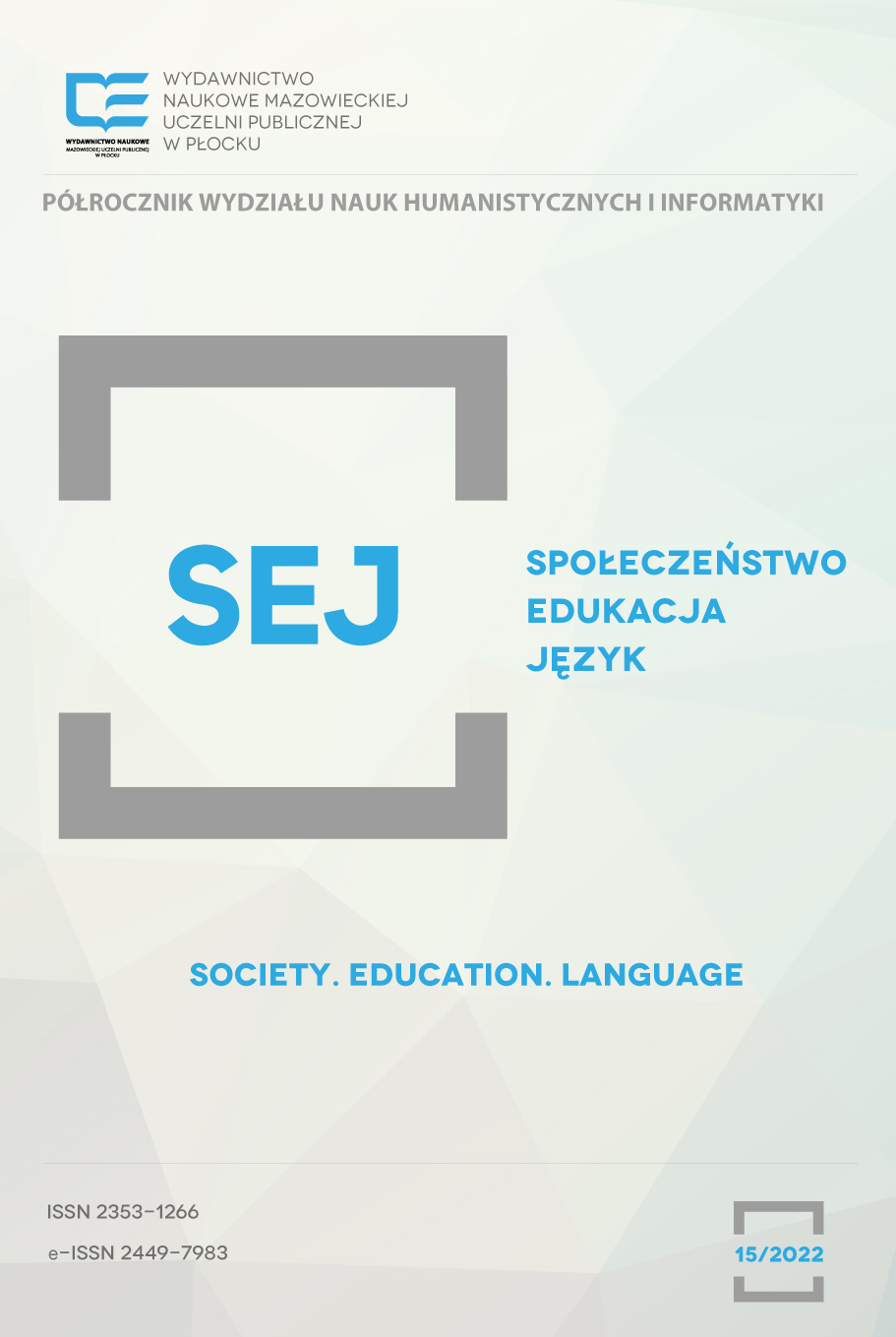Are Polish pupils of older school age open to "otherness"? Some comments about pupils’ attitudes to “Others” in the context of social determinants
DOI:
https://doi.org/10.19251/sej/2022.15(10)Keywords:
sociodemographic and social determinants, “Other”, pupils of older school age, social exclusionAbstract
The article presents results of the research affects older school age students’ reference to the “Others” in the context of sociodemographic and – more broadly - social determinants. I pointed to four factors of distinctness and six categories „Others”. Research group involves pupils of older school age (15-year-old) from inclusive school and non inclusive school in Cracow.
Research has shown that students from school for all are more accepting toward „Others” than pupils from inclusive school. It means, that attendance to inclusive class does not have an influence on higher level of „Others” acceptance. Analyzes have shown that there are some aspects affecting older school age student’s positive attitude towards „Others”, e.g.: contact with the „Others” in peer groups and also in neighbourhood (local environment).
References
Aronson, Elliot. 2009. „The Social Animal”, Warszawa: PWN.
Allport, Gordon. 1954. „The nature of prejudice”, Reading, MA: Addison Wesley.
Berger, Peter, Luckmann Thomas. 1983. „The Social Construction of Reality”, Warszawa: PIW.
Bilewicz, Michał. 2006. „When does contact reduce prejudice? Social and temporal categorizations as conditions for the effectiveness of intergroup contact”, In Social Psychology 02 (02), www.spoleczna.psychologia.pl/pliki/2006_2/Bilewicz_2006_2.pdf, [access: 14.03.2020].
Bronfenbrenner, Urie. 1970. „Social factors in personality development”, In: Educational psychology, nr 1.
Chodkowska, Maria., Byra, Stanisław. 2012. „Social distance in pedagogical theory and practice”, Lublin: Wyd. UMCS.
The Salamanca statement and framework for action on special needs education world conference on special needs education: access and quality Salamanca, Spain, 7-10 June 1994, https://www.european-agency.org/sites/default/files/salamanca-statement-and-framework.pdf [access: 14. 03. 2020].
Doroba-Sawa, Marta. 2010. „Normalization, integration and social inclusion in the life of people with disabilities: possibilities and limitations”, Special needs school, nr 1.
Dovidio, John., Gaertner, Samuel. L., Kawakami, Kerry. 2003. “Intergroup contact: The past, present, and the future”. Group Processes and Intergroup Relations, 6(1).
Dykcik, Władysław. 1996. „Conditions and possibilities of cultural transmission of social attitudes and behaviors towards autonomy and isonomy of people with intellectual disabilities”, In Dykcik, Władysław. (ed.) „Society and the autonomy of people with disabilities”, Poznań: "Eruditus".
„Fans of differences”, zob. https://web.facebook.com/wielbiciele.roznic/?_rdc=1&_rdr, [access: 14. 04. 2019]
Fudali, Maria. 2009. „Informal youth groups operating in the middle school”, Zielona Góra: Uniwersytet Zielonogórski.
Gaertner, Samuel. Dovidio, John. 2000. «Reducing intergroup bias: The common ingroup identity model». Philadelphia, PA: Psychology Press.
Gajdzica, Zenon. 2011. „Difficult situations in the opinion of teachers of integration classes”, Kraków – Katowice: Impuls.
Garbat, Marcin. 2003. „Barriers in the environment of people with disabilities”, In Frąckiewicz, Lucyna. (ed.) „Education of people with disabilities”, Katowice: Wydawnictwo Uniwersytetu Śląskiego.
Ministry of Education, Education of people with disabilities http://bimen.gov.pl/men_bip/akty_pr_1997-2006/rozp_84.php?wrapper=test [access: 14.03.2019].
Hulek, Aleksander. 1980. „Pedagogika rewalidacyjna”, Warszawa: PWN.
Hurrelmann, Karl. 1994. „Social structure and personality development”, Poznań: UAM.
Janiszewska – Nieścioruk, Zdzisława. 1999. „Determinants of the effects of social integration”, In Maciarz, A. (ed.) „From the theory and research of social integration of disabled children”, Kraków: „Impuls”.
Karolczak – Biernacka, Barbara. 1995. „Attitudes of young people towards minorities” In Nikitorowicz, Jerzy. (ed.) „Intercultural education. In the circle of needs, expectations and stereotypes”, Białystok: TRANS HUMANA.
Karwowska, Małgorzata. 2007. „Inclusive education problems in the opinion of the teaching Staff” In Janiszewska – Nieścioruk, Zdzisława. (ed.) „Problems of inclusive education of children and youth with intellectual disabilities”, Kraków: „Impuls”.
Convention on Combating Discrimination in Education, http://www.prawo.pl/dz-u-akt/-/dokument/Dz.U.1964.40.268/16786171/18199/drukuj, [access: 14.03.2019].
Krause, Amadeusz. 2003. „Multiple levels of integration - consequences for theory and practice” In Chodkowska Maria. (ed.) „Multidimensionality of integration in educational theory and practice”, Lublin: UMCS.
Miller, Norman. Brewer, Marilynn. Edwards, Keith. 1985. “Cooperative interaction in desegregated settings: A laboratory analogue”. Journal of Social Issues, 41.
“Labyrinth of human rights”, http://www.mlodziez.org.pl/dofinansowalismy/labyrinth-human-rights.html, [access: 14. 04. 2019 r.],
”Zoom on DiverCity”, http://www.mlodziez.org.pl/dofinansowalismy/zoom-divercity.html, [access: 14.03.2019],
Noelle, Veronika. 1995. ”Schuler sehen Schule Anders: eine empirische Untersuchung uber Schulauffassungen von Schulern Und Ihren Konsens”, Frankfurt am Main–Berlin–Bern–New York–Paris–Wien: Peter Lang Verlag.
„From the exclusion to the inclusion of people with disabilities - inclusive education as a chance for a better tomorrow?” http://pedagogikaspecjalna.tripod.com/notes/fromexclusiontoinclusion.html [access: 14. 03. 2019 r.]
“Policy Guidelines on Inclusion in Education”, http://unesdoc.unesco.org/images/0017/001778/177849e.pdf, Guidelines for Inclusion: “Ensuring Access to Education for All”, http://unesdoc.unesco.org/images/0014/001402/140224e.pdf [access: 14.03.2018],
„Regulation of the Minister of National Education and Sport” (31. 01. 2002) (Dz.U. nr 10 z 2002 r. poz. 96, § 15 ust. 2.) http://bimen.gov.pl/men_bip/akty_pr_1997-2006/rozp_134.php?wrapper=test, [access: 14.03.2019].
Rzedzicka, Krystyna. 2005. „Learning as the way (towards) normalization of relations with the Other”, In Kossakowski, Czesław. Krause, Amadeusz. „Standardization of the living environments of people with disabilities. Discourses of special education 4”, Olsztyn: Wyd. UWM.
Sherif, Muzafer. Harvey, O. J., White, Jack., Hood, William. R., Sherif, Carolyn. In: 1961. Intergroup cooperation and competition: The Robbers Cave experiment. Norman, OK: University Book Exchange.
Sherif, Muzafer., Sherif Carolyn., 1956. “An outline of social psychology”, New York: Harper and Bros.
Smoter, Katarzyna. 2017. „Determinants of the attitude of middle school students from integration and non-integration classes to others”, Humanistic education nr 1. pp. 101 – 112.
Smoter, Katarzyna. 2016. „Determinants of the attitude of middle school students to others”, Uniwersytet Jagielloński, Cracow, Unpublished doctoral dissertation.
Stephan, Walter. G., Stephan Cookie. W. 1999. „Group influence. Relationship psychology”, Gdańsk: GWP.
Szumski, Grzegorz. 2006. „Inclusive education for the disabled people”, Warszawa: PWN.
The Act of September 7, 1991 on the Education System. Dz.U. 1991 nr 95 poz. 425 http://isasejm.gov.pl/ DetailsServlet?id=WDU19910950425 [access: 14. 03. 2020 r.]
„Youth in action”, zob. m.in. http://www.mlodziez.org.pl/, [access: 14. 04. 2019 r.].
